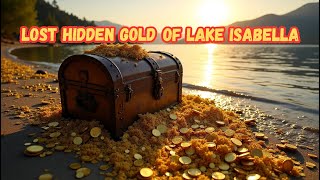Lost Treasure: Hidden Gold of Lake Isabella in California
Lost Treasure: Hidden Gold of Lake Isabella in California

Legend: After the California Gold Rush, rumors swirled about prospectors hiding large quantities of gold nuggets and dust near Lake Isabella to protect it from thieves. Many believed it was buried around the Kern River Canyon.
Search Area: Near Lake Isabella and Kern River.
Mystery: Over the years, there have been scattered finds of gold nuggets, but the “mother lode” treasure remains missing, enticing treasure hunters to explore the rugged terrain.
The Gold of the Isabella Lake Area
Nestled in the Sierra Nevada Mountains, Lake Isabella is a tranquil reservoir with scenic views and abundant wildlife. But beneath its serene surface lies a legend that has captivated the hearts of treasure hunters and history buffs for over a century. The tale of the hidden gold of the Isabella Lake area is a story of hope, desperation, and mystery that continues to lure adventurers into the rugged terrain of Kern County.
The Origins of the Legend
The story begins in the mid-19th century, during the California Gold Rush. The Kern River Canyon, which feeds into Lake Isabella, was a hotspot for prospectors seeking their fortunes. The riverbanks glittered with the promise of gold, and miners flocked to the area with dreams of striking it rich. For some, those dreams came true. Accounts from the time tell of men pulling substantial quantities of gold dust and nuggets from the river’s waters.
But prosperity often breeds danger. Bandits roamed the hills, preying on unsuspecting miners returning from the claims. To safeguard their fortunes, it is said that some prospectors resorted to burying their gold near the Kern River and its surrounding areas. Among these hidden treasures, the most famous is the so-called “mother lode” — a stash so large and valuable that its exact location was a closely guarded secret.
Clues and Scattered Finds
Over the decades, stories of the hidden gold passed from one generation to the next. While some dismissed it as folklore, others took the legend seriously. Treasure hunters combed the hillsides and riverbanks, armed with maps, metal detectors, and shovels. Occasionally, their efforts bore fruit. Scattered reports of gold nuggets discovered near the Kern River lent credibility to the tale. These finds, though modest, fueled speculation that the mother lode might still be out there, waiting to be uncovered.
One such discovery occurred in the early 20th century, when a local rancher stumbled upon a small cache of gold dust hidden in a rusted tin can. The rancher’s story reignited interest in the legend, drawing a new wave of adventurers to the region. In the 1960s, a group of amateur prospectors claimed to have found an old miner’s campsite with evidence of gold-panning activities. Although they didn’t find the mother lode, their discovery deepened the mystery, suggesting that the hidden treasure might indeed be real.
Challenges of the Terrain
Searching for gold in the Isabella Lake area is no easy task. The landscape is rugged and unforgiving, with steep cliffs, dense vegetation, and unpredictable weather. The Kern River itself is known for its treacherous currents, earning it the nickname “Killer Kern.” These natural obstacles have deterred many would-be treasure hunters, leaving the area largely unexplored.
Adding to the difficulty is the lack of concrete clues. Over time, the geography of the region has changed. The creation of Lake Isabella in 1953 submerged large portions of the original Kern River Valley, potentially burying the treasure under hundreds of feet of water. Despite these challenges, the legend persists, and modern technology offers new hope. Advanced metal detectors, ground-penetrating radar, and underwater drones have become essential tools for today’s treasure hunters.
Theories and Speculation
Several theories attempt to explain the origin and fate of the hidden gold. Some believe it was the work of a single prospector who, fearing robbery, buried his fortune and never returned to retrieve it. Others speculate that it was a collective effort by a group of miners who hid their gold to protect it from bandits or rival claimants.
One intriguing theory suggests that the treasure might not be gold at all but a hoard of valuable artifacts, documents, or gemstones. Proponents of this idea point to historical accounts of Spanish explorers and Native American tribes in the area, arguing that the treasure’s origins could predate the Gold Rush.
